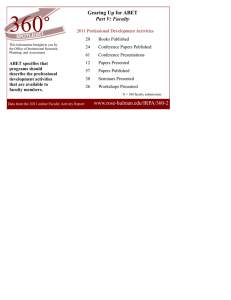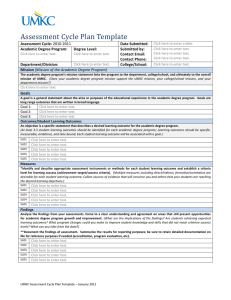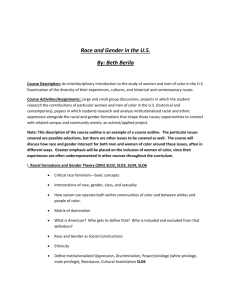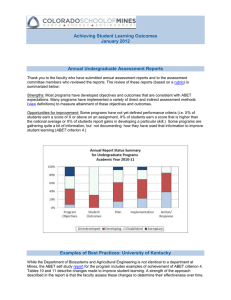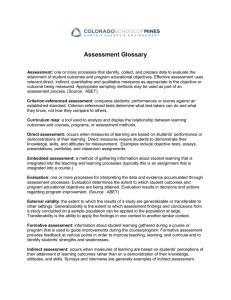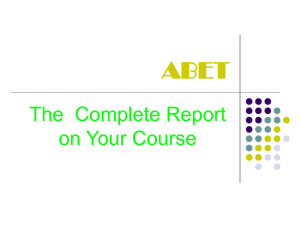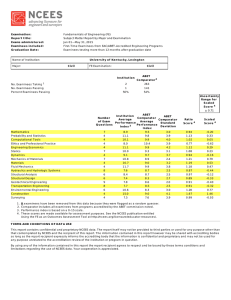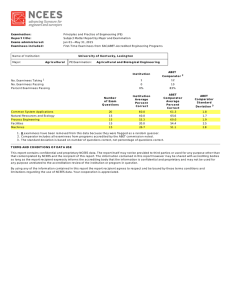Program Assurance of Quality – preview –
advertisement
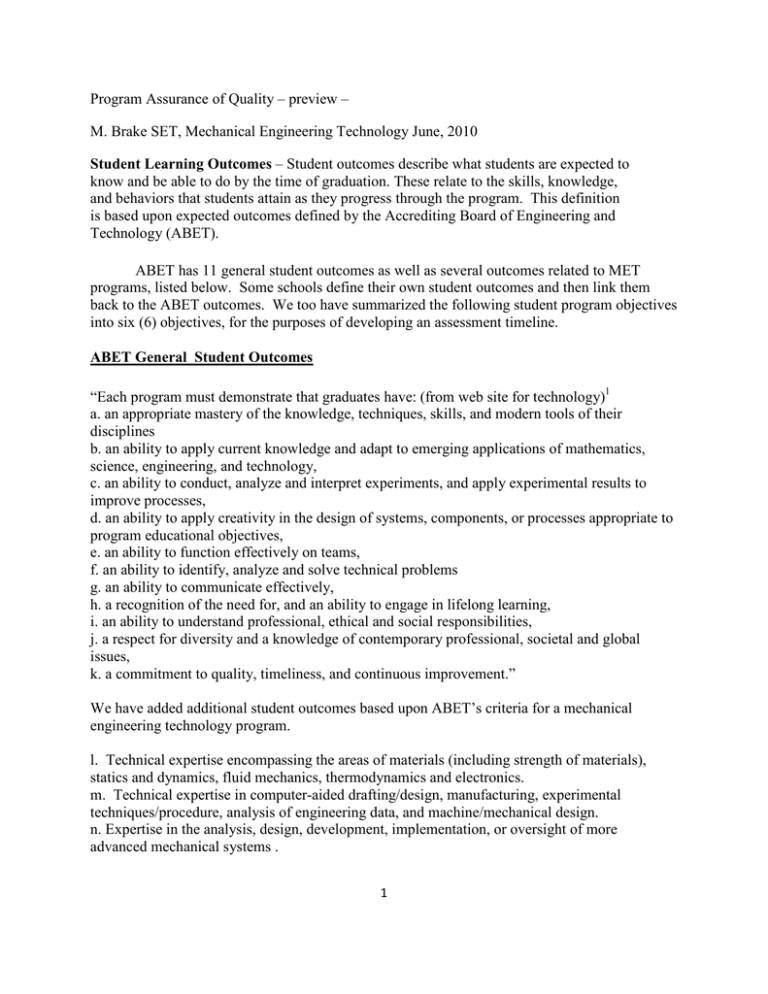
Program Assurance of Quality – preview – M. Brake SET, Mechanical Engineering Technology June, 2010 Student Learning Outcomes – Student outcomes describe what students are expected to know and be able to do by the time of graduation. These relate to the skills, knowledge, and behaviors that students attain as they progress through the program. This definition is based upon expected outcomes defined by the Accrediting Board of Engineering and Technology (ABET). ABET has 11 general student outcomes as well as several outcomes related to MET programs, listed below. Some schools define their own student outcomes and then link them back to the ABET outcomes. We too have summarized the following student program objectives into six (6) objectives, for the purposes of developing an assessment timeline. ABET General Student Outcomes “Each program must demonstrate that graduates have: (from web site for technology)1 a. an appropriate mastery of the knowledge, techniques, skills, and modern tools of their disciplines b. an ability to apply current knowledge and adapt to emerging applications of mathematics, science, engineering, and technology, c. an ability to conduct, analyze and interpret experiments, and apply experimental results to improve processes, d. an ability to apply creativity in the design of systems, components, or processes appropriate to program educational objectives, e. an ability to function effectively on teams, f. an ability to identify, analyze and solve technical problems g. an ability to communicate effectively, h. a recognition of the need for, and an ability to engage in lifelong learning, i. an ability to understand professional, ethical and social responsibilities, j. a respect for diversity and a knowledge of contemporary professional, societal and global issues, k. a commitment to quality, timeliness, and continuous improvement.” We have added additional student outcomes based upon ABET’s criteria for a mechanical engineering technology program. l. Technical expertise encompassing the areas of materials (including strength of materials), statics and dynamics, fluid mechanics, thermodynamics and electronics. m. Technical expertise in computer-aided drafting/design, manufacturing, experimental techniques/procedure, analysis of engineering data, and machine/mechanical design. n. Expertise in the analysis, design, development, implementation, or oversight of more advanced mechanical systems . 1 Our curriculum consists of the following requirements: Table 1: Required courses and their relationship to student outcomes. ET 100 CHEM 121/122 PHYS 223 Mech, Sound PHYS 223 Electricity&Light ELEC 200 Circuits ELEC 218 Motors MATH 105/107 alg/trig MATH 120 Calc I MATH 122 Calc II SET 350 Writing for Eng. MET 211 Statics MET 312 Dynamics MET 313 Mech. of Mat. MET 314 Thermo/Heat MET 319 Fluids MET 387 Co-op Ed MET 411 Machine Design MET 434 Finite Element MET 437 Kin. Machines MET 470 Vibrations MET 492 Senior Design I MET 493 Senior Design II PDD 111 Materials PDD 122 Eng. Graphics PDD 223 Man. Processes MFG 316 Design for Man. Total cr a 3 4 5 5 3 3 5 4 4 3 3 3 3 3 3 3 3 3 3 2 3 3 3 4 4 3 88 x b c x x x x x x d. e x x f. g. h. i. j. x x x x k. x x l. m . n. x x x x x x x x x x x x x x x x x x x x x x x x x x x x x x x x x x x x x x x x x x x x x x x x x General Education: 40 credits Program Requirements: 88 credits Total: 128 credits 2 x x x x x x x x x x x x x x x x x x x x x x x x x x x x x x x x x x x x x EMU Student Learning Outcomes These are a combination of the a – n outcomes to streamline the assessment process. Assessment of individual program outcomes, summarized in the previous a – n list will be embedded in the Student Program Outcomes (SPO) assessment plan. SLO1. (a,b,f, l) Students will be able to identify, analyze, and solve technical problems using current knowledge of emerging applications of math, science, engineering and technology and in the process acquire an appropriate mastery of the knowledge, techniques, skills and modern tools of MET. SLO2. (c, e, g, m) Students will be able to conduct, analyze and interpret experiments or projects, and analyze data and apply experimental results to improve processes by working in teams and then communicating their results both orally and in written form. SLO3. (d,n) Students will demonstrate their expertise in the analysis, design, development and implementation of more advanced mechanical systems by applying their creativity in the design of systems or processes. SLO4. (h,k) Students will incorporate a commitment to quality, timeliness and continuous improvement to these systems of processes. In the process of designing systems or processes, they will recognize a need for lifelong learning. SLO5. (m) Students will demonstrate expertise in computer-aided design, manufacturing, experimental techniques, machine and mechanical design. SLO6. (i, j,) Students will learn the advantages of diversity and knowledge of contemporary professional, societal and global issues as well as understand the professional, ethical and social responsibilities that are needed to take part in a global community. Table 2. Timeline for Assessing Student Learning Outcomes Student Program Objective SLO1 SLO2 SLO3 SLO4 SLO5 SLO6 ’08-‘09 x x ’09-10 10-11 x x 11-12 x x 12-13 13-14 x x x x 3 x x
